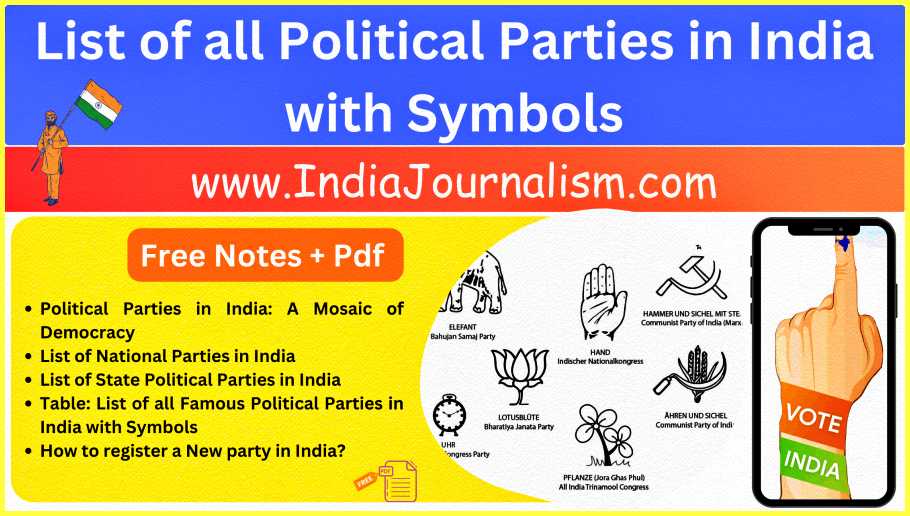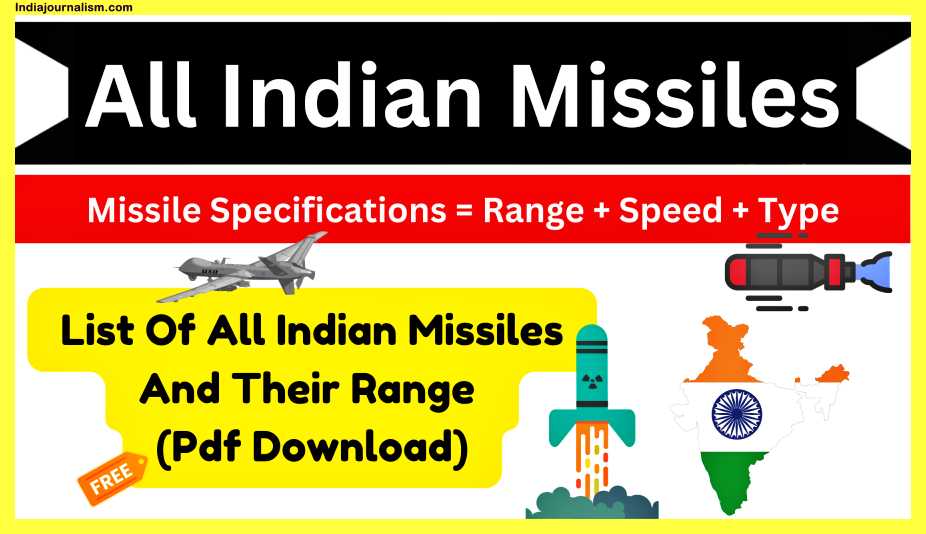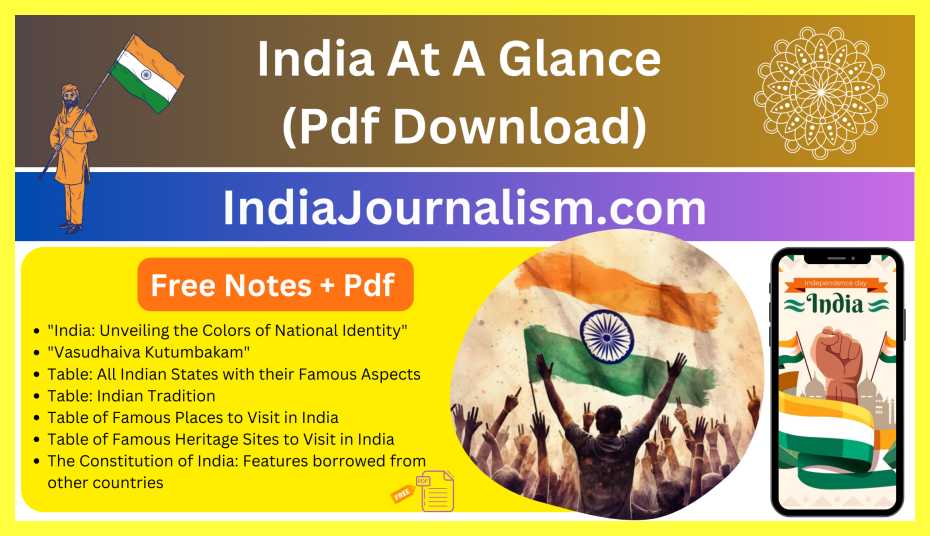List of all Political Parties in India with Symbols (PDF)
List of all Political Parties in India with Symbols PDF Download and you can download this page as a Pdf in All Languages in 1 click (ICON: see on your right Top side), just go to the end of this page you will get a PDF Download Button and this PDF is very Important for your Upcoming Exams like UPSC, SSC, BANK, etc.
- India, the world’s largest democracy, boasts a vibrant and diverse political landscape characterized by numerous political parties catering to the nation’s multifaceted population. From national parties with a pan-India presence to regional parties focusing on specific states, India’s political spectrum mirrors its rich cultural and social diversity. In this article, we will explore the extensive list of political parties in India, highlighting their significance and contributions to the democratic process.
Political Parties in India: A Mosaic of Democracy
India, the world’s largest democracy, is a vibrant tapestry of political ideologies, regional interests, and social movements. Central to this democratic fabric are political parties, the lifeblood of India’s electoral system. In 2023, India boasts a multi-party system, where a plethora of parties, both national and state-level, shape the nation’s political discourse. Let’s delve into this intricate mosaic of political entities that define India’s democratic spirit.
National Parties:
At the national level, six prominent parties dominate the political stage. These are:
- AAP (Aam Aadmi Party): Emerging as a beacon of anti-corruption and pro-people governance, AAP gained prominence in Delhi and has expanded its footprint in various states.
- BSP (Bahujan Samaj Party): Championing the cause of marginalized communities, BSP primarily represents Scheduled Castes, Scheduled Tribes, and Other Backward Classes.
- BJP (Bharatiya Janata Party): With its roots in Hindu nationalism, BJP is a right-wing party and currently holds the reins of the central government, led by Prime Minister Narendra Modi.
- Congress (Indian National Congress): As one of the oldest political parties in India, Congress has played a significant role in shaping the nation’s destiny. It aligns itself with center-left ideologies.
- CPI-M (Communist Party of India-Marxist): Rooted in Marxist principles, CPI-M is a left-wing party with strongholds in states like Kerala and West Bengal.
- NPP (National People’s Party): Breaking regional barriers, NPP stands out as the first national party from the North-East region, championing the region’s unique interests.
State Parties and Beyond:
- India’s political diversity extends to the state level, where more than 56 recognized parties cater to regional aspirations. These state parties, often deeply rooted in local cultures and histories, play a crucial role in shaping policies at the state and regional levels.
- However, the political spectrum doesn’t end here. India is also home to a staggering 2,597 unregistered parties. While these entities might lack official recognition, they reflect the democratic fervor of the nation, representing a myriad of causes and beliefs.
Recognition and Privileges:
- The Election Commission of India (ECI) bestows recognition upon political parties based on specific criteria. Parties meeting these criteria enjoy privileges such as a reserved party symbol, free broadcast time on state-run media, and consultation in determining election dates. The ECI periodically reviews the recognized party status to ensure compliance with the established criteria.
A Democratic Melting Pot:
- India’s political parties, whether national, state-level, or unregistered entities, collectively create a vibrant democratic ecosystem. As the country marches forward, these parties serve as the voice of millions, embodying the essence of India’s diverse populace. In this intricate mosaic of democracy, every party, regardless of its size or recognition, contributes to the grand narrative of India’s democratic journey, reflecting the nation’s ethos of unity in diversity.
Table: List of National Parties in India
The political landscape of India, the world’s largest democracy, is a dynamic tapestry woven with various ideologies and regional interests. As of April 2023, India is home to six national parties, each representing a unique perspective and influencing the nation’s political discourse. Here is an overview of these parties:
Here’s the table:
| Sl. No. + Name | Abbreviation | Founding Date |
|---|---|---|
| 1. Bharatiya Janata Party (BJP) | BJP | 6 April 1980 |
| 2. Indian National Congress (INC) | INC | 28 December 1885 |
| 3. Communist Party of India (Marxist) (CPI-M) | CPI-M | 7 November 1964 |
| 4. Aam Aadmi Party (AAP) | AAP | 26 November 2012 |
| 5. Bahujan Samaj Party (BSP) | BSP | 14 April 1984 |
| 6. National People’s Party (NPP) | NPP | 6 January 2013 |
National Parties in India: A Snapshot
- Bharatiya Janata Party (BJP): Founded on 6th April 1980, the BJP has emerged as one of India’s major political forces. It is known for its right-wing ideologies and strong advocacy for Hindu nationalism.
- Indian National Congress (INC): With roots dating back to 28th December 1885, the INC is one of the oldest political parties in India. Positioned as a center-left party, it has played a significant role in shaping the country’s history post-independence.
- Communist Party of India (Marxist) (CPI-M): Founded on 7th November 1964, the CPI-M is rooted in Marxist principles. It has strongholds in states like Kerala and West Bengal and is influential in labor and farmer movements.
- Aam Aadmi Party (AAP): A relatively new entrant, AAP was established on 26th November 2012. It gained prominence for its anti-corruption stance and people-centric governance, particularly in the National Capital Territory of Delhi.
- Bahujan Samaj Party (BSP): Founded on 14th April 1984, BSP primarily represents the interests of Scheduled Castes, Scheduled Tribes, and Other Backward Classes. It champions social justice and empowerment.
- National People’s Party (NPP): NPP is a notable party from the North-East region, founded on 6th January 2013. It is recognized for its regional focus, advocating for the unique needs of the North-Eastern states.
It’s important to note that on 10th April 2023, the Election Commission of India made significant changes to India’s political landscape. The national party status of three former parties – the Trinamool Congress (TMC), the Nationalist Congress Party (NCP), and the Communist Party of India (CPI) – was revoked. Simultaneously, the Aam Aadmi Party (AAP) led by Arvind Kejriwal was recognized as a national party, reducing the count of national parties from eight to six. This development underscores the fluidity and ever-changing nature of Indian politics, reflecting the diverse voices and opinions within the country.
List of State Political Parties in India
A registered political party in India must meet to be recognized as a “State Political Party.” This recognition is important as it grants certain privileges and status to the party within the specific state in which it operates. The conditions for achieving state party status are as follows:
- Minimum Seats in the Legislative Assembly: To qualify as a state party, a political party must either win a minimum of 3% of the total seats in the State Legislative Assembly or secure a minimum of 3 seats in that assembly. This condition emphasizes that the party must have a significant presence in the state’s legislative body.
- Lok Sabha Representation: Alternatively, a party can achieve state party status by winning at least one seat in the Lok Sabha (the lower house of India’s national parliament) for every 25 Lok Sabha seats allotted to that state. This condition ensures that the party has a reasonable representation at the national level.
- Vote Percentage and Seats: Another pathway to becoming a state political party is by securing at least 6% of the total valid votes polled in a general election to the Lok Sabha or State Legislative Assembly. In addition to this, the party must win at least one seat in the Lok Sabha and two seats in the State Legislative Assembly in the same election. This condition underscores the party’s broader popularity and electoral strength.
- Liberalized Criteria: In addition to the above conditions, a more flexible criterion has been introduced. Even if a political party fails to win any seats in a State in a general election to the Lok Sabha or State Legislative Assembly, it can still qualify for recognition as a State Party if it manages to secure 8% or more of the total valid votes polled in the state. This clause allows for recognition based on the party’s significant popular support, even if it doesn’t secure seats.
In essence, these conditions are designed to ensure that a political party has a meaningful presence, either in terms of seats or popular support, within a particular state to be recognized as a State Political Party. Once recognized, the party is entitled to certain privileges and a distinct status within that state’s political landscape.
Table: List of State Political Parties in India
Here is a comprehensive list of State Political Parties in India, each representing specific regions or states and playing a crucial role in shaping the country’s political landscape. These parties, with their unique ideologies and regional focuses, contribute significantly to India’s diverse democratic process.
| Name | Abbreviation | Foundation Year | States/UT Represented |
|---|---|---|---|
| All India Anna Dravida Munnetra Kazhagam | AIADMK | 1972 | Puducherry, Tamil Nadu |
| All India Forward Bloc | AIFB | 1939 | West Bengal |
| All India Majlis-e-Ittehadul Muslimeen | AIMIM | 1927 | Telangana |
| All India N.R. Congress | AINRC | 2011 | Puducherry |
| All India United Democratic Front | AIUDF | 2004 | Assam |
| All Jharkhand Students Union | AJSU | 1986 | Jharkhand |
| Asom Gana Parishad | AGP | 1985 | Assam |
| Biju Janata Dal | BJD | 1997 | Odisha |
| Bodoland People’s Front | BPF | 1985 | Assam |
| Desiya Murpokku Dravidar Kazhagam | DMDK | 2005 | Tamil Nadu |
| Dravida Munnetra Kazhagam | DMK | 1949 | Puducherry, Tamil Nadu |
| Indian Union Muslim League | IUML | 1948 | Kerala |
| Hill State People’s Democratic Party | HSPDP | 1968 | Meghalaya |
| Indian National Lok Dal | INLD | 1999 | Haryana |
| Jammu & Kashmir National Conference | JKNC | 1932 | Jammu & Kashmir |
| Jammu & Kashmir National Panthers Party | JKNPP | 1982 | Jammu & Kashmir |
| Jammu & Kashmir Apni Party | JKAP | 2020 | Jammu & Kashmir |
| Jammu and Kashmir People’s Democratic Party | JKPDP | 1998 | Jammu & Kashmir |
| Janata Dal (Secular) | JD(S) | 1999 | Karnataka, Kerala |
| Janata Dal (United) | JD(U) | 1999 | Bihar |
| Lok Jan Shakti Party | LJP | 2000 | Bihar |
| Jharkhand Mukti Morcha | JMM | 1972 | Jharkhand |
| Rashtriya Lok Dal | RLD | 1996 | Uttar Pradesh |
| People’s Democratic Front | 2017 | Meghalaya | |
| Kerala Congress (M) | KC(M) | 1979 | Kerala |
| Maharashtra Navnirman Sena | MNS | 2006 | Maharashtra |
| Maharashtrawadi Gomantak Party | MGP | 1963 | Goa |
| United People’s Party Liberal | UPPL | 2015 | Assam |
| Mizo National Front | MNF | 1959 | Mizoram |
| Mizoram People’s Conference | MPC | 1972 | Mizoram |
| Naga People’s Front | NPF | 2002 | Manipur, Nagaland |
| Nationalist Democratic Progressive Party | NDPP | 2017 | Nagaland |
| Pattali Makkal Katchi | PMK | 1989 | Puducherry, Tamil Nadu |
| People’s Party of Arunachal | PDA | 1977 | Arunachal Pradesh |
| Rashtriya Janata Dal | RJD | 1997 | Bihar, Jharkhand |
| Rashtriya Loktantrik Party | RLP | 2020 | Rajasthan |
| Zoram Nationalist Party | ZNP | 1997 | Mizoram |
| Revolutionary Socialist Party | RSP | 1940 | Kerala, West Bengal |
| Samajwadi Party | SP | 1992 | Uttar Pradesh |
| Shiromani Akali Dal | SAD | 1920 | Punjab |
| Shiv Sena | SS | 1966 | Maharashtra |
| Sikkim Democratic Front | SDF | 1993 | Sikkim |
| Sikkim Krantikari Morcha | SKM | 2013 | Sikkim |
| Telangana Rashtra Samithi | TRS | 2001 | Telangana |
| Telugu Desam Party | TDP | 1982 | Andhra Pradesh, Telangana |
| Tipra Motha Party | TMP | 2022 | Tripura |
| United Democratic Party | UDP | 1972 | Meghalaya |
| YSR Congress Party | YSRCP | 2011 | Andhra Pradesh, Telangana |
| Samajwadi Janata Party (Rashtriya) | SJP | 1990 | Uttar Pradesh |
| Communist Party of India (Marxist–Leninist) Liberation | CPI (ML)L | 1974 | Bihar |
| Goa Forward Party | GFP | 2016 | Goa |
| Indigenous People’s Front of Tripura | IPFT | 2009 | Tripura |
| Janta Congress Chhattisgarh | JCC | 2016 | Chhattisgarh |
| Jan Nayak Janta Party | JJP | 2018 | Haryana |
These state political parties, by catering to the specific needs and aspirations of their respective regions, significantly contribute to India’s diverse and multifaceted political landscape. Each party, with its unique ideology, plays a crucial role in shaping the socio-political fabric of its state or union territory.
List of all Famous Political Parties in India with Symbols
Here is the list of All Famous Political Parties in India with Symbols:
Indian National Congress
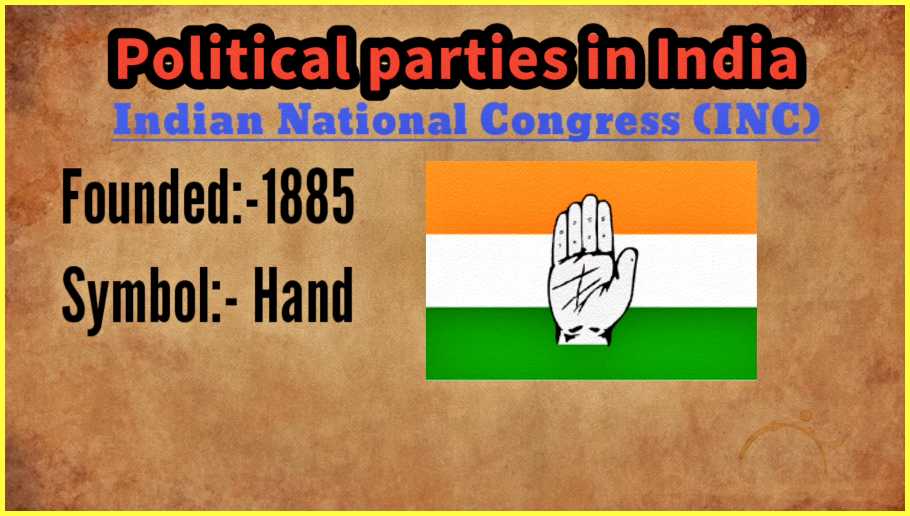
Here is a table that outlines some basic information about the party Indian National Congress:
| Founded | 28th December 1885 |
|---|---|
| Founder | Allan Octavian Hume (British civil servant) and prominent Indian leaders including Dadabhai Naoroji, Dinshaw Wacha, and William Wedderburn |
| Current President | Sonia Gandhi (as of last update) |
| Headquarters | 24, Akbar Road, New Delhi, India |
| Ideology | Social democracy, Secularism, Populism |
| Political Position | Centre-left |
| Alliance | United Progressive Alliance (UPA) |
| Symbol | Hand (Hasta Mudra) |
| Official Website | Indian National Congress |
| Major Historical Figures | Mahatma Gandhi, Jawaharlal Nehru, Indira Gandhi, Rajiv Gandhi |
| Significant Achievements | Instrumental in India’s freedom struggle, Leading party in the early post-independence years, Major social and economic reforms |
The Indian National Congress: Shaping India’s Destiny
The Indian National Congress (INC), often simply referred to as the Congress, holds a paramount position in India’s political history. Established on 28th December 1885, the party played a central role in the country’s struggle for independence from British colonial rule. Led by iconic figures like Mahatma Gandhi, Jawaharlal Nehru, Indira Gandhi, and numerous others, the INC became the principal force behind India’s freedom movement.
- Historical Significance: The INC’s early years were marked by efforts to unify diverse Indian communities and foster a collective identity against colonial oppression. The party’s leaders advocated for civil rights, social justice, and self-governance, ultimately leading India toward its independence on 15th August 1947.
- Post-Independence Contributions: After independence, the INC became the ruling party and continued to shape India’s political, social, and economic landscape. Under the leadership of Jawaharlal Nehru, India’s first Prime Minister, the country pursued a path of democratic socialism, emphasizing secularism, social justice, and economic development.
- Leadership and Evolution: Over the years, the INC has seen various leaders guiding its path, each contributing to India’s growth. Indira Gandhi, Nehru’s daughter, served as Prime Minister and implemented significant reforms. The party has adapted to changing political scenarios, addressing emerging challenges and evolving its policies to align with modern India’s needs.
- Challenges and Resilience: The INC faced challenges and underwent transformations, particularly in the era of economic liberalization in the 1990s. Despite electoral ups and downs, the party has remained a prominent force in Indian politics, participating in alliances and coalitions to influence the national agenda.
- Contributions to Social Reforms: Throughout its journey, the INC championed social reforms, education, and economic development. It introduced policies to uplift marginalized communities, promote gender equality, and enhance educational opportunities. The party has been instrumental in shaping India’s modern education system and healthcare initiatives.
- Contemporary Role: In contemporary politics, the INC continues to be a major player, especially in national politics. It participates in debates on issues ranging from economic policies to social reforms, contributing to the democratic discourse of the nation. The INC’s ideology emphasizes inclusivity, secularism, and social welfare, aligning with its historical roots.
Conclusion: The Indian National Congress stands as a testament to the spirit of resilience, adaptability, and the democratic ethos that defines India’s political landscape. As the world’s largest democracy navigates its path into the future, the INC remains a vital force, shaping and reflecting the aspirations of millions of Indians.
Bharatiya Janata Party (BJP)
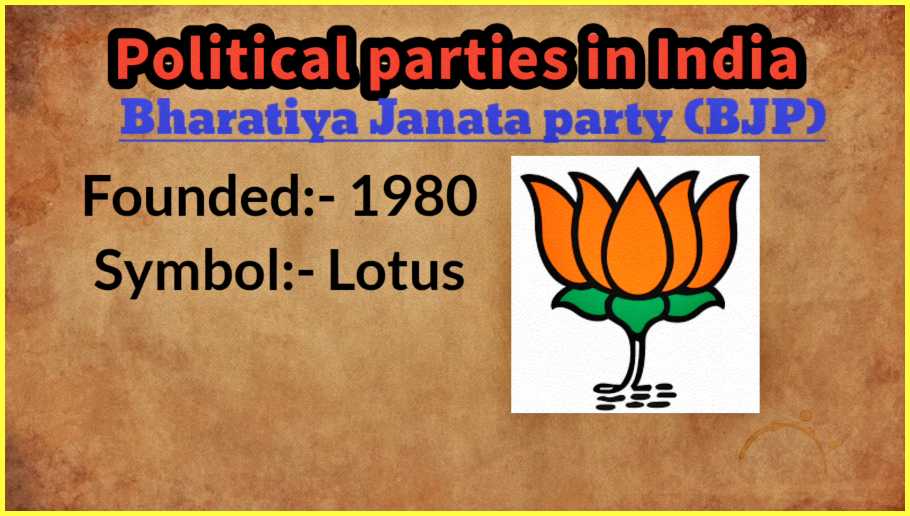
Here’s a detailed table providing an overview of the Bharatiya Janata Party (BJP):
| Founded | 6th April 1980 |
|---|---|
| Founder | Atal Bihari Vajpayee, L.K. Advani, and others |
| Current President | Jagat Prakash Nadda (as of last update) |
| Headquarters | 6-A, Deen Dayal Upadhyaya Marg, New Delhi, India |
| Ideology | Hindutva, Nationalism, Social Conservatism, Integral Humanism |
| Political Position | Right-wing |
| Alliance | National Democratic Alliance (NDA) |
| Symbol | Lotus (Kamal) |
| Official Website | Bharatiya Janata Party |
| Key Historical Leaders | Atal Bihari Vajpayee, L.K. Advani, Narendra Modi, Amit Shah |
| Major Achievements | Economic Reforms, Infrastructure Development, National Security Initiatives, Electoral Victories in Various States |
Bharatiya Janata Party (BJP): Navigating India’s Political Landscape
The Bharatiya Janata Party (BJP) stands as a cornerstone in Indian politics, shaping the nation’s trajectory since its establishment on 6th April 1980. Founded by stalwarts like Atal Bihari Vajpayee, L.K. Advani, and others, the BJP has evolved into one of India’s most influential political entities.
- Foundation and Ideology: The BJP’s ideological foundation lies in Hindutva, which emphasizes the cultural and religious unity of India’s predominantly Hindu population. Alongside this, the party advocates nationalism, social conservatism, and integral humanism. Its symbol, the Lotus (Kamal), has become synonymous with its identity.
- Key Leaders: Over the years, the BJP has been helmed by visionary leaders, including Atal Bihari Vajpayee, L.K. Advani, and in contemporary times, Narendra Modi and Amit Shah. These leaders have played pivotal roles in shaping the party’s policies and national agenda.
- Political Position and Alliances: As a right-wing political party, the BJP occupies a significant position in India’s political spectrum. It is a key constituent of the National Democratic Alliance (NDA), a coalition of center-right and right-wing parties. The BJP’s political influence extends to both national and state levels, making it a formidable force in Indian politics.
- Policy Initiatives and Achievements: The BJP has been at the forefront of initiating transformative policy measures. Economic reforms, infrastructure development, national security initiatives, and social welfare programs have marked the party’s tenure. It has also championed initiatives such as ‘Swachh Bharat Abhiyan’ (Clean India Campaign) and ‘Make in India’, aimed at fostering cleanliness and boosting domestic manufacturing.
- Electoral Triumphs: One of the BJP’s notable achievements is its string of electoral victories. The party has secured significant mandates in various state assemblies and the Lok Sabha (the lower house of India’s parliament). Its ability to garner public support has enabled the BJP to implement its agenda across diverse regions of India.
- Challenges and Adaptability: Throughout its journey, the BJP has faced challenges and criticisms. However, the party has displayed adaptability by embracing modern communication strategies, effectively utilizing social media, and connecting with the youth demographic. It has successfully integrated technology into its campaigns, enabling it to engage with a wider audience.
Conclusion: The Bharatiya Janata Party’s journey reflects the dynamic nature of Indian politics. From its origins to its current status as a dominant political force, the BJP has continuously evolved, adapting to societal changes and political landscapes. As it continues to shape India’s future, the party’s resilience, adaptability, and ideological convictions remain key pillars in the country’s democratic framework.
All India Trinamool Congress (AITC)
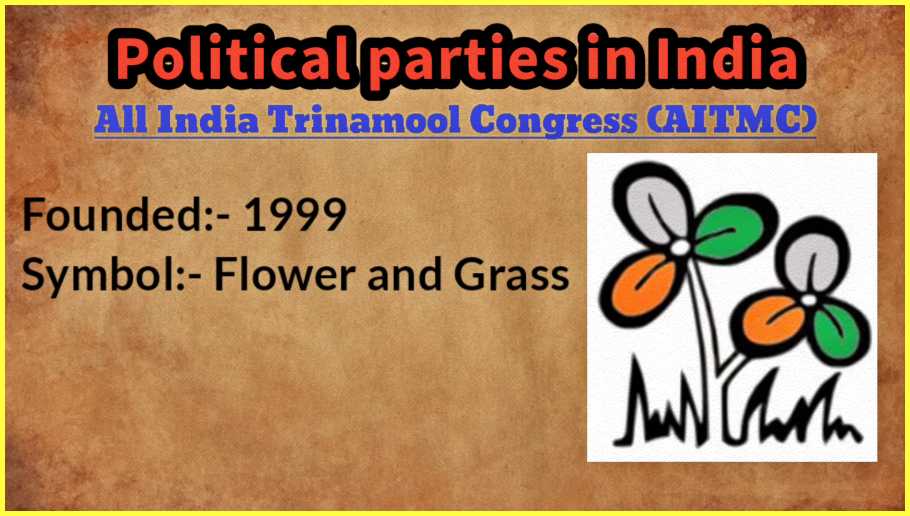
Here’s a detailed table providing an overview of the All India Trinamool Congress (AITC):
| Founded | 1st January 1998 |
|---|---|
| Founder | Mamata Banerjee |
| Current Chairperson | Mamata Banerjee (as of last update) |
| Headquarters | 30B Harish Chatterjee Street, Kolkata, West Bengal, India |
| Ideology | Populism, Regionalism, Secularism |
| Political Position | Centre-left |
| Alliance | United Progressive Alliance (UPA) |
| Symbol | Flowers and Grass (Jora Ghas Phul) |
| Official Website | All India Trinamool Congress |
| Key Historical Leaders | Mamata Banerjee, Mukul Roy, Derek O’Brien |
| Major Achievements | Historic Electoral Victories in West Bengal, Social Welfare Programs, Infrastructural Development in West Bengal |
All India Trinamool Congress (AITC): Empowering the Grassroots
The All India Trinamool Congress (AITC) stands as a prominent political force in India, particularly in the state of West Bengal. Founded on 1st January 1998 by Mamata Banerjee, the party has significantly influenced the political landscape, championing the cause of regionalism, populism, and secularism.
- Founding and Ideology: AITC was founded by Mamata Banerjee, a charismatic and determined leader known for her grassroots connect. The party’s ideology revolves around populism, emphasizing the needs and aspirations of the common people. Trinamool, which translates to ‘grassroots,’ underscores the party’s commitment to representing the interests of ordinary citizens.
- Key Leaders: Mamata Banerjee, the founder, and chief architect of AITC, has been instrumental in shaping the party’s ideology and political strategies. Other prominent leaders within the party include Mukul Roy and Derek O’Brien, both of whom have played crucial roles in AITC’s growth and influence.
- Political Position and Alliances: AITC is generally considered a center-left party, focusing on social welfare, economic development, and regional empowerment. It is part of the United Progressive Alliance (UPA), a coalition of center-left and left-wing political parties in India. The party’s electoral strategies often involve connecting with the grassroots population, addressing their concerns, and focusing on inclusive development.
- Electoral Triumphs: AITC gained significant attention and respect through its historic electoral victories, especially in West Bengal. Under Mamata Banerjee’s leadership, the party won multiple state assembly elections, securing mandates from the people of West Bengal. These victories highlighted AITC’s ability to connect with the masses and implement policies that resonated with the public.
- Social Welfare Initiatives: AITC has been notable for its social welfare initiatives, focusing on healthcare, education, and poverty alleviation. The party implemented several welfare programs aimed at improving the lives of ordinary citizens, showcasing a commitment to social justice and development.
- Challenges and Adaptability: Like any political entity, AITC faced challenges, including opposition from rival parties and the need to adapt to changing political landscapes. The party navigated these challenges through grassroots mobilization, effective communication strategies, and a commitment to its core ideology.
Conclusion: The All India Trinamool Congress, with its emphasis on grassroots empowerment and social welfare, has emerged as a key player in Indian politics, particularly in the state of West Bengal. Its ability to connect with the people, implement developmental policies, and address societal concerns has solidified its position as a party representing the aspirations of the common citizens. As it continues to evolve, the AITC remains a significant force shaping the political discourse of the region.
Bahujan Samaj Party (BSP)
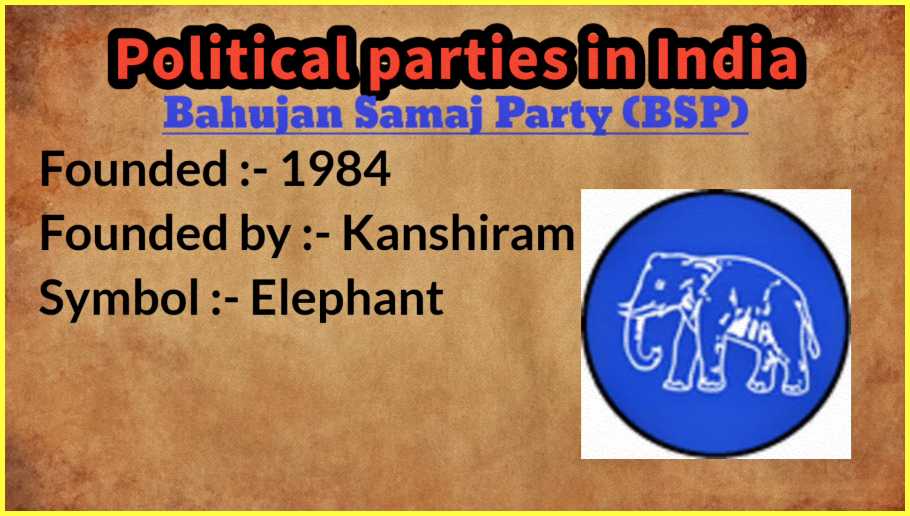
Here’s a detailed table providing an overview of the Bahujan Samaj Party (BSP):
| Founded | 14th April 1984 |
|---|---|
| Founder | Kanshi Ram |
| Current President | Mayawati (as of last update) |
| Headquarters | 12, Gurudwara Rakabganj Road, New Delhi, India |
| Ideology | Bahujan ideology, Social Justice, Equality |
| Political Position | Centre-left to Left-wing |
| Symbol | Elephant (Haathi) |
| Official Website | Bahujan Samaj Party |
| Key Historical Leaders | Kanshi Ram, Mayawati, Satish Chandra Mishra |
| Major Achievements | Historic Electoral Victories in Uttar Pradesh, Advocacy for Dalit and Marginalized Communities, Social Welfare Initiatives |
Bahujan Samaj Party (BSP): Championing Social Justice and Empowerment
The Bahujan Samaj Party (BSP) is a prominent political party in India, with a strong focus on advocating for the rights and welfare of marginalized communities, especially Dalits (Scheduled Castes), Scheduled Tribes, and Other Backward Classes. Founded on 14th April 1984 by Kanshi Ram, the party has been a significant force in the political landscape of the country, particularly in the state of Uttar Pradesh.
- Foundation and Ideology: The BSP was established with a unique ideology rooted in social justice and equality. The term “Bahujan” translates to “the majority of the people” and signifies the party’s commitment to representing the interests of the socially and economically disadvantaged sections of society. The party aims to uplift Dalits, tribal communities, and other marginalized groups, addressing their concerns and advocating for their rights.
- Leadership and Influence: Kanshi Ram, the founder of BSP, laid the foundation for a movement that aimed to empower the socially oppressed. His protege, Mayawati, a charismatic and influential leader, succeeded him and became a significant political figure in Uttar Pradesh. Under her leadership, the party achieved historic victories, especially in Uttar Pradesh state elections, demonstrating its strong grassroots support.
- Political Strategy and Symbol: The BSP is well-known for its electoral symbol, the Elephant (Haathi), which has become a symbol of strength and resilience. The party’s political strategies often involve consolidating the Dalit vote bank, forging alliances with other parties when necessary, and emphasizing the need for social and economic justice in Indian society.
- Advocacy and Achievements: The party’s primary focus has been on advocating for social and economic equality. It has been vocal about the need for reservations and affirmative action policies to uplift marginalized communities. BSP-led governments in Uttar Pradesh have initiated various welfare programs, aiming to improve education, healthcare, and living conditions for Dalits and other disadvantaged groups.
- Challenges and Resilience: The BSP has faced challenges, including electoral competition and changing political dynamics. Despite setbacks, the party has displayed resilience, adapting its strategies and continuing to be a prominent voice for social justice and empowerment.
Conclusion: The Bahujan Samaj Party remains a vital political entity in India, championing the cause of the marginalized and striving for a more equitable society. Its ideology, rooted in social justice, continues to resonate with millions of Indians, making it an essential player in shaping the nation’s political discourse and advocating for the rights of those historically oppressed.
Nationalist Congress Party (NCP)
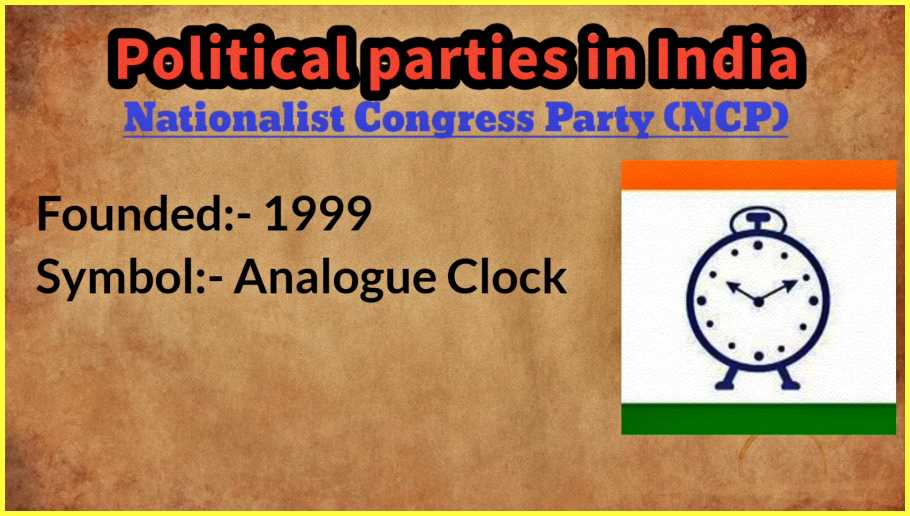
Here’s a detailed table providing an overview of the Nationalist Congress Party (NCP):
| Founded | 25th May 1999 |
|---|---|
| Founder | Sharad Pawar |
| Current President | Sharad Pawar (as of last update) |
| Headquarters | 10, Sansad Marg, New Delhi, India |
| Ideology | Secularism, Social Democracy, Agrarianism |
| Political Position | Centre-left |
| Symbol | Clock (Ghadi) |
| Official Website | Nationalist Congress Party |
| Key Historical Leaders | Sharad Pawar, Praful Patel, Supriya Sule |
| Major Achievements | Active Participation in National Politics, Advocacy for Farmers and Rural Development, Welfare Initiatives in Maharashtra |
Communist Party of India (CPI)
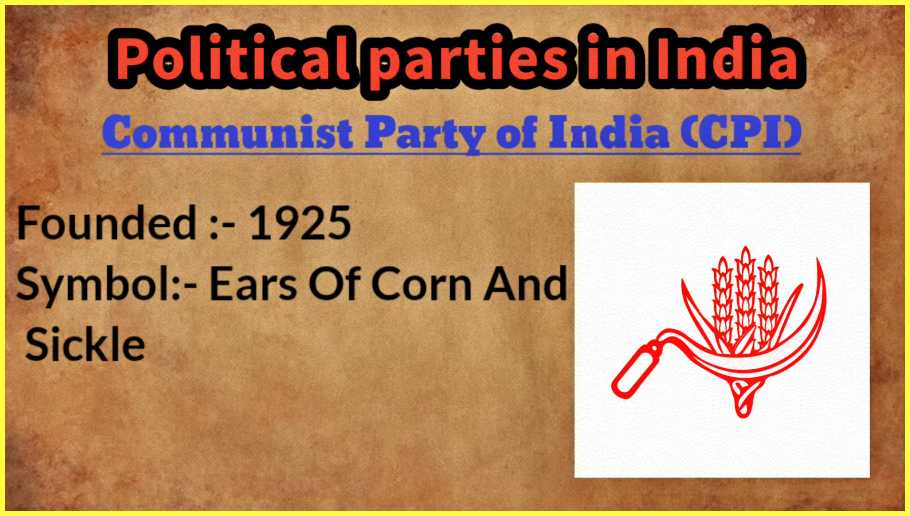
Here’s a detailed table providing an overview of the Communist Party of India (CPI):
| Founded | 26th December 1925 |
|---|---|
| Founders | S.A. Dange, M.N. Roy, Evelyn Trent Roy, and others |
| Current General Secretary | Sitaram Yechury (as of last update) |
| Headquarters | Ajoy Bhavan, 15 Purana Qila Road, New Delhi, India |
| Ideology | Marxism-Leninism, Secularism, Socialism |
| Political Position | Left-wing |
| Alliance | Left Front |
| Symbol | Ears of Corn and Sickle (Jyothi) |
| Official Website | Communist Party of India |
| Key Historical Leaders | S.A. Dange, A.K. Gopalan, E.M.S. Namboodiripad, B.T. Ranadive |
| Major Achievements | Active Participation in Indian Independence Movement, Advocacy for Workers’ Rights, Land Reforms, and Social Justice |
Communist Party of India (Marxist) (CPI(M))
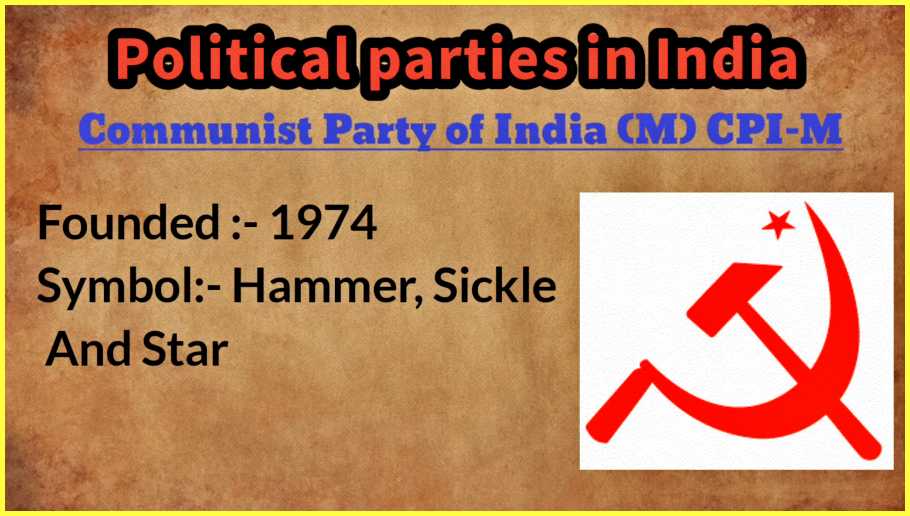
Here’s the updated table for the Communist Party of India (Marxist) (CPI(M)):
| Founded | 1964 (Formally Split from CPI in 1964, Independent Party since 1974) |
|---|---|
| Founders | E.M.S. Namboodiripad, A.K. Gopalan, Jyoti Basu, and others |
| Current General Secretary | Sitaram Yechury (as of last update) |
| Headquarters | AKG Bhavan, Bhai Veer Singh Marg, New Delhi, India |
| Ideology | Marxism-Leninism, Secularism, Socialism |
| Political Position | Left-wing |
| Alliance | Left Front, United Progressive Alliance (Outside Support) |
| Symbol | Hammer, Sickle, and Star (Ears of Corn and Sickle in some states) |
| Official Website | Communist Party of India (Marxist) |
| Key Historical Leaders | E.M.S. Namboodiripad, Jyoti Basu, Harkishan Singh Surjeet, Prakash Karat |
| Major Achievements | Active Participation in National and State Politics, Advocacy for Workers’ Rights, Land Reforms, and Social Justice |
Samajwadi Party (SP)
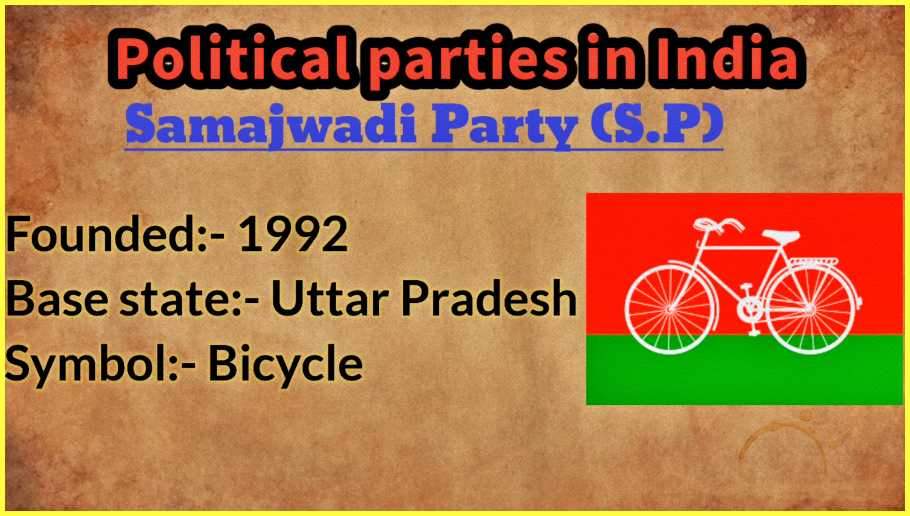
Here’s a detailed table providing an overview of the Samajwadi Party (SP):
| Founded | 4th October 1992 |
|---|---|
| Founder | Mulayam Singh Yadav |
| Current President | Akhilesh Yadav (as of last update) |
| Headquarters | 19 Vikramaditya Marg, Lucknow, Uttar Pradesh, India |
| Ideology | Socialism, Secularism, Democratic Socialism |
| Political Position | Centre-left |
| Alliance | Samajwadi Secular Morcha (Regional Alliance in Uttar Pradesh) |
| Symbol | Bicycle (Cycle) |
| Official Website | Samajwadi Party |
| Key Historical Leaders | Mulayam Singh Yadav, Akhilesh Yadav, Ram Gopal Yadav |
| Major Achievements | Multiple Terms as the ruling party in Uttar Pradesh, Advocacy for Social Welfare Programs, Rural Development Initiatives |
Rashtriya Janata Dal (RJD)

Here’s a detailed table providing an overview of the Rashtriya Janata Dal (RJD):
| Founded | 5th July 1997 |
|---|---|
| Founder | Lalu Prasad Yadav |
| Current President | Lalu Prasad Yadav (as of last update) |
| Headquarters | 13, Jai Prakash Narayan Marg, Patna, Bihar, India |
| Ideology | Socialism, Secularism, Democratic Socialism |
| Political Position | Centre-left |
| Alliance | Mahagathbandhan (Grand Alliance in Bihar) |
| Symbol | Hurricane Lamp (RJD’s official symbol in Bihar) |
| Official Website | Rashtriya Janata Dal |
| Key Historical Leaders | Lalu Prasad Yadav, Rabri Devi, Tejashwi Yadav |
| Major Achievements | Multiple Terms as the ruling party in Bihar, Advocacy for Social Welfare Programs, Rural Development Initiatives |
Janata Dal (United) (JDU)
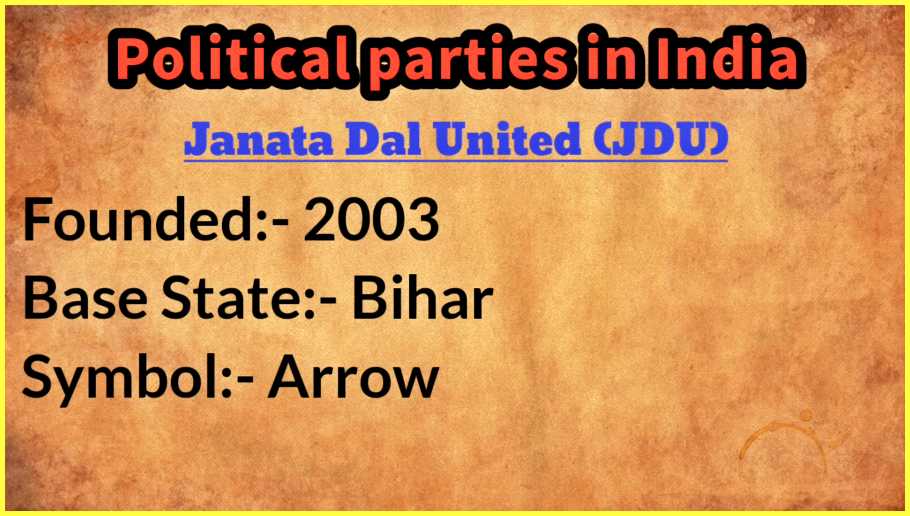
Here’s a detailed table providing an overview of the Janata Dal (United) (JDU):
| Founded | 30th October 2003 |
|---|---|
| Founder | Sharad Yadav, Nitish Kumar, George Fernandes, and others |
| Current President | Nitish Kumar (as of last update) |
| Headquarters | Jantar Mantar Road, New Delhi, India |
| Ideology | Socialism, Secularism, Integral Humanism |
| Political Position | Centre-left to Centre |
| Alliance | National Democratic Alliance (NDA) |
| Symbol | Arrow (Teer) |
| Official Website | Janata Dal (United) |
| Key Historical Leaders | Nitish Kumar, Sharad Yadav, George Fernandes |
| Major Achievements | Multiple Terms as the ruling party in Bihar, Advocacy for Social Welfare Programs, Rural Development Initiatives |
Shiv Sena
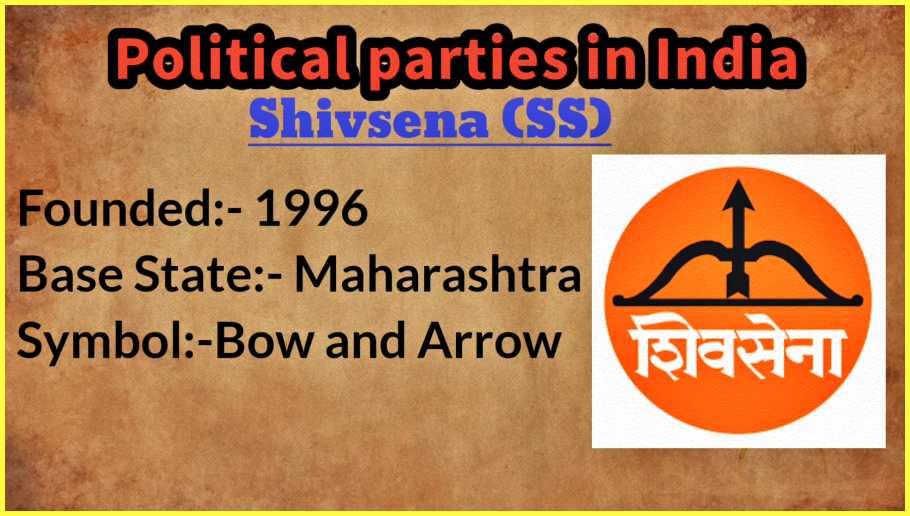
Here’s a detailed table providing an overview of Shiv Sena:
| Founded | 19th June 1966 |
|---|---|
| Founder | Bal Thackeray |
| Current Chief Minister (as of last update) | Uddhav Thackeray |
| Headquarters | Shiv Sena Bhavan, Dadar, Mumbai, Maharashtra, India |
| Ideology | Hindutva, Marathi Regionalism, Social Conservatism |
| Political Position | Right-wing to Far-right |
| Alliance | Maha Vikas Aghadi (Coalition in Maharashtra with NCP and Congress) |
| Symbol | Bow and Arrow (Dhanushya) |
| Official Website | Shiv Sena |
| Key Historical Leaders | Bal Thackeray, Uddhav Thackeray, Aditya Thackeray |
| Major Achievements | Multiple Terms in Maharashtra Government, Advocacy for Marathi Rights, Cultural and Social Initiatives in Maharashtra |
Aam Aadmi Party (AAP)
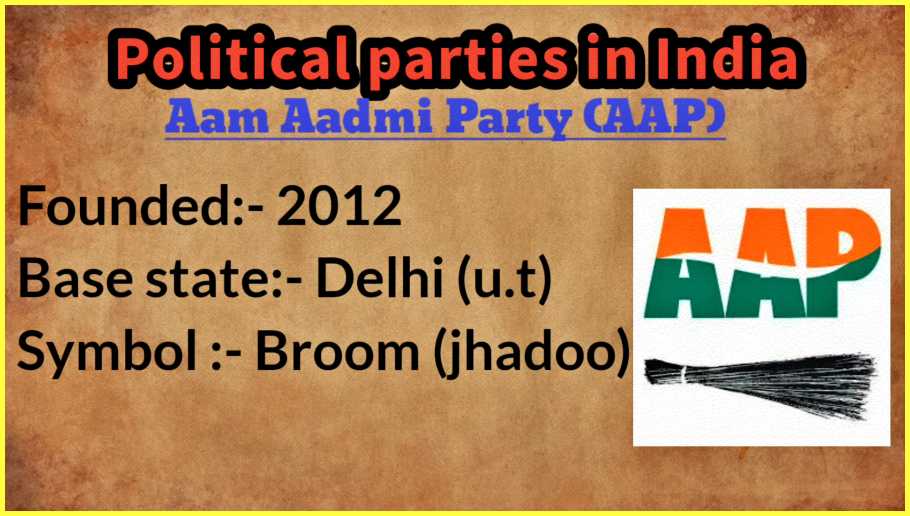
Here’s a detailed table providing an overview of the Aam Aadmi Party (AAP):
| Founded | 26th November 2012 |
|---|---|
| Founders | Arvind Kejriwal, Prashant Bhushan, and others |
| Current Convenor | Arvind Kejriwal (as of last update) |
| Headquarters | Aam Aadmi Party National Headquarters, Delhi, India |
| Ideology | Anti-Corruption, Direct Democracy, Secularism |
| Political Position | Centre-left |
| Alliance | None (AAP contested independently in most elections) |
| Symbol | Broom (Jhadu) |
| Official Website | Aam Aadmi Party |
| Key Historical Leaders | Arvind Kejriwal, Manish Sisodia, Kumar Vishwas |
| Major Achievements | Multiple Terms in Delhi Government, Implementation of Welfare Schemes, Advocacy for Transparency and Accountability in Politics |
Dravida Munnetra Kazhagam (DMK)

Here’s a detailed table providing an overview of the Dravida Munnetra Kazhagam (DMK):
| Founded | 17th September 1949 |
|---|---|
| Founder | C.N. Annadurai |
| Current President | M.K. Stalin (as of last update) |
| Headquarters | Anna Arivalayam, 367-369, Anna Salai, Teynampet, Chennai, Tamil Nadu, India |
| Ideology | Social Democracy, Dravidian Nationalism, Secularism |
| Political Position | Centre-left |
| Alliance | Secular Progressive Alliance (United Progressive Alliance at the national level) |
| Symbol | Rising Sun (Udaya Anbu) |
| Official Website | Dravida Munnetra Kazhagam |
| Key Historical Leaders | C.N. Annadurai, M. Karunanidhi, M.K. Stalin, K. Kamaraj |
| Major Achievements | Multiple Terms in Tamil Nadu Government, Advocacy for Dravidian Rights, Social Justice Reforms |
All India Anna Dravida Munnetra Kazhagam (AIADMK)
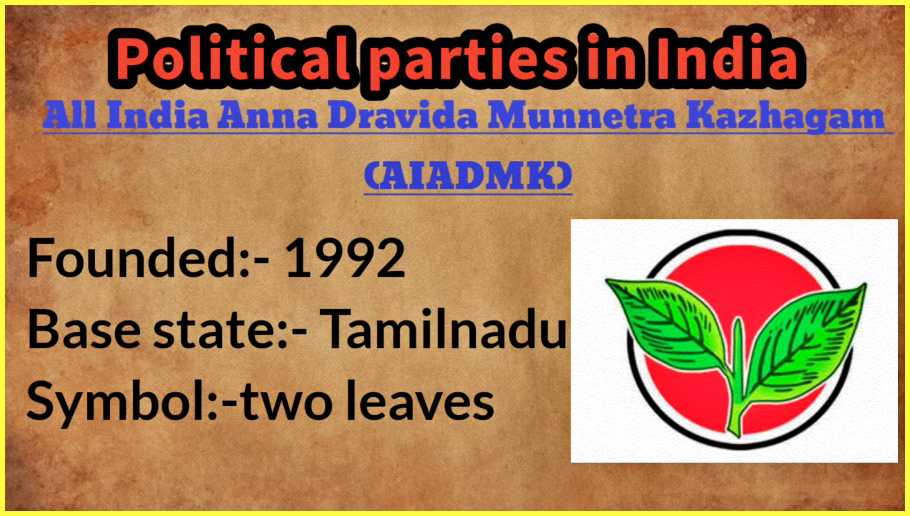
Correct it: Party Founded in 1972*
Here’s a detailed table providing an overview of the All India Anna Dravida Munnetra Kazhagam (AIADMK):
| Founded | 17th October 1972 |
|---|---|
| Founder | M.G. Ramachandran (MGR) |
| Current General Secretary | Edappadi K. Palaniswami (as of last update) |
| Headquarters | Avvai Shanmugam Salai, Royapettah, Chennai, Tamil Nadu, India |
| Ideology | Dravidian Nationalism, Social Democracy, Secularism |
| Political Position | Centre-left |
| Alliance | Secular Progressive Alliance (United Progressive Alliance at the national level) |
| Symbol | Two Leaves (Dual Leaves) |
| Official Website | AIADMK |
| Key Historical Leaders | M.G. Ramachandran, J. Jayalalithaa, M. Karunanidhi (During the party’s alliance with DMK) |
| Major Achievements | Multiple Terms in Tamil Nadu Government, Implementation of Welfare Schemes, Advocacy for Dravidian Rights |
Biju Janata Dal (BJD)
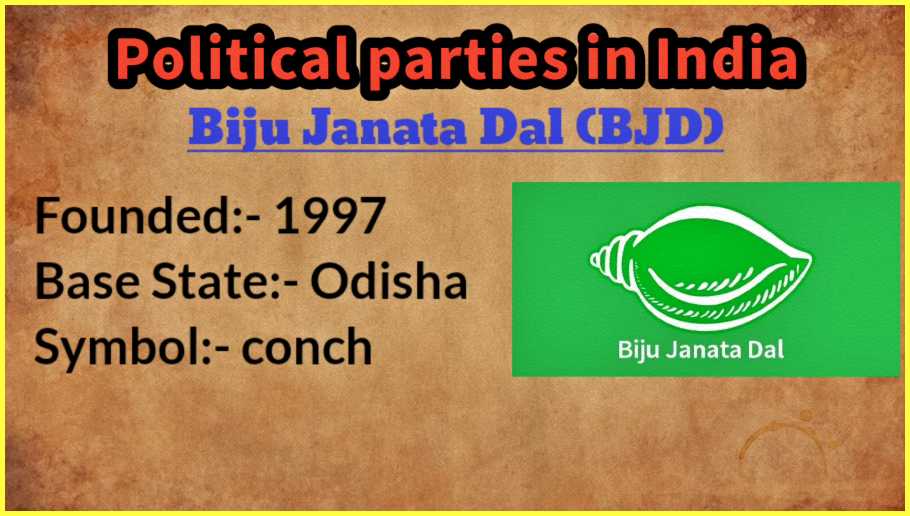
Here’s a detailed table providing an overview of the Biju Janata Dal (BJD):
| Founded | 26th December 1997 |
|---|---|
| Founder | Naveen Patnaik |
| Current President | Naveen Patnaik (as of last update) |
| Headquarters | Naveen Nivas, Forest Park, Bhubaneswar, Odisha, India |
| Ideology | Regionalism, Populism, Social Welfare, Secularism |
| Political Position | Centre-left |
| Alliance | None (BJD primarily contests elections independently) |
| Symbol | Conch Shell (Shankha) |
| Official Website | Biju Janata Dal |
| Key Historical Leaders | Naveen Patnaik |
| Major Achievements | Multiple Terms in Odisha Government, Implementation of Welfare Schemes, Advocacy for Regional Development and Social Welfare |
Telugu Desam Party (TDP)
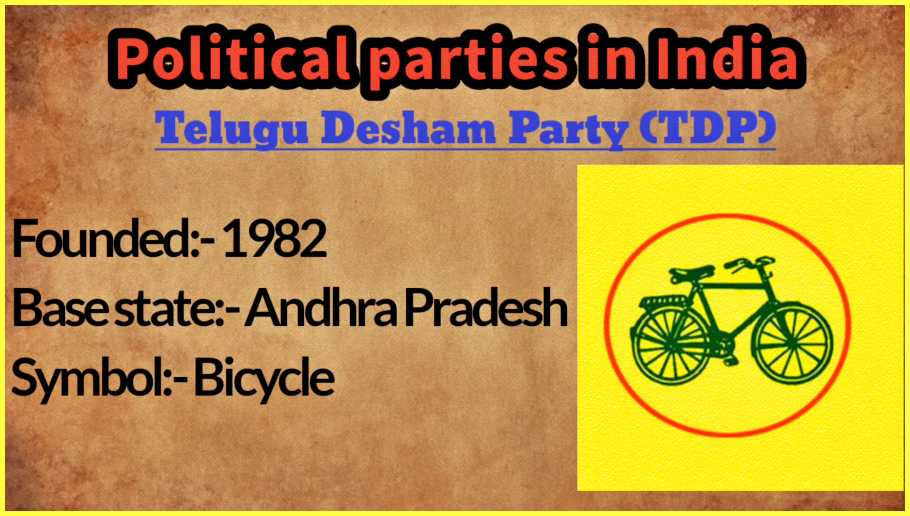
Here’s a detailed table providing an overview of the Telugu Desam Party (TDP):
| Founded | 29th March 1982 |
|---|---|
| Founder | Nandamuri Taraka Rama Rao (NTR) |
| Current President | Nara Chandrababu Naidu (as of last update) |
| Headquarters | NTR Bhavan, Road No. 2, Banjara Hills, Hyderabad, Telangana, India |
| Ideology | Regionalism, Populism, Social Welfare, Secularism |
| Political Position | Centre-right |
| Alliance | None (TDP primarily contests elections independently) |
| Symbol | Bicycle (Cycle) |
| Official Website | Telugu Desam Party |
| Key Historical Leaders | Nandamuri Taraka Rama Rao, Nara Chandrababu Naidu, Nara Lokesh |
| Major Achievements | Multiple Terms in Andhra Pradesh Government, Implementation of Welfare Schemes, Advocacy for Regional Development and Social Welfare |
Yuvajana Sramika Rythu Congress Party (YSRCP)
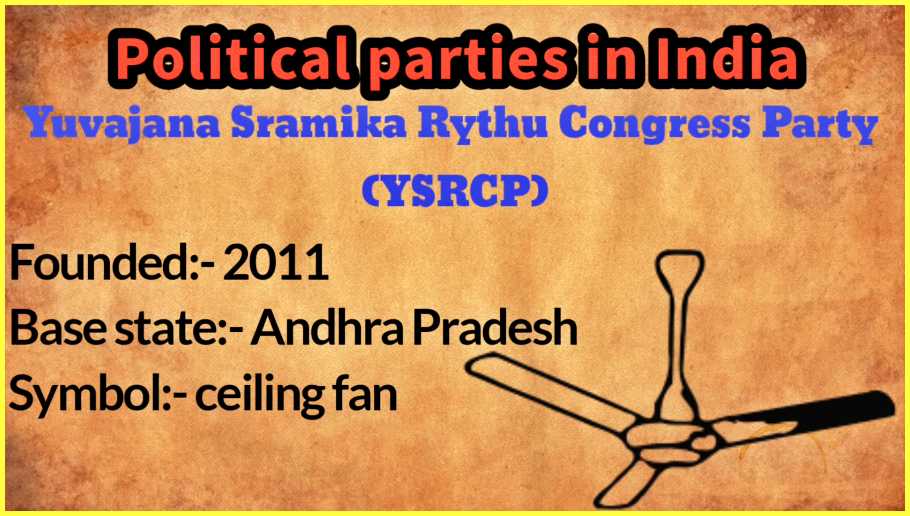
Here’s a detailed table providing an overview of the Yuvajana Sramika Rythu Congress Party (YSRCP):
| Founded | 12th March 2011 |
|---|---|
| Founder | Y.S. Jagan Mohan Reddy |
| Current President | Y.S. Jagan Mohan Reddy (as of last update) |
| Headquarters | Lotus Pond, Jubilee Hills, Hyderabad, Telangana, India |
| Ideology | Regionalism, Populism, Social Welfare, Secularism |
| Political Position | Centre-left |
| Alliance | None (YSRCP primarily contests elections independently) |
| Symbol | Ceiling Fan (Padyam) |
| Official Website | YSR Congress Party |
| Key Historical Leaders | Y.S. Jagan Mohan Reddy, Y.S. Rajasekhara Reddy |
| Major Achievements | Current ruling party in Andhra Pradesh, Implementation of Welfare Schemes, Advocacy for Social Justice and Welfare |
Telangana Rashtra Samithi (TRS)
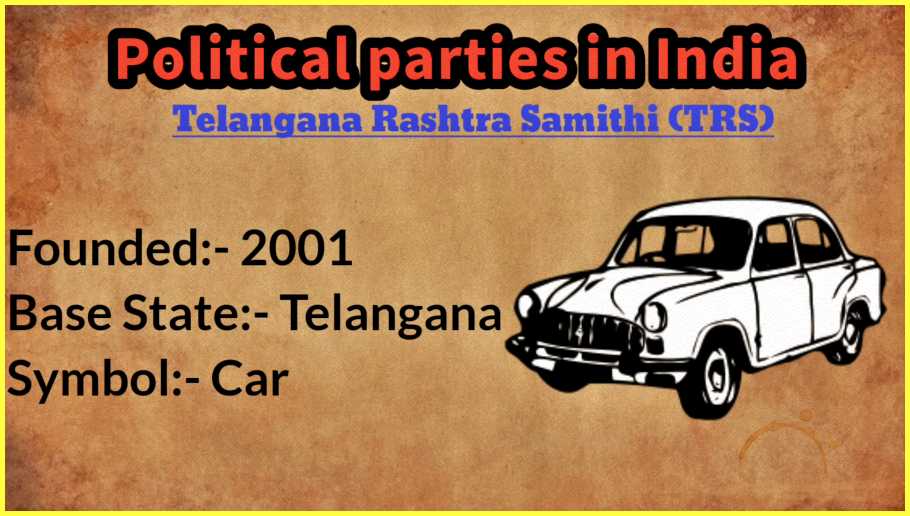
Here’s a detailed table providing an overview of the Telangana Rashtra Samithi (TRS):
| Founded | 27th April 2001 |
|---|---|
| Founder | K. Chandrashekar Rao (KCR) |
| Current President | K. Chandrashekar Rao (as of last update) |
| Headquarters | Telangana Bhavan, Road No. 12, Banjara Hills, Hyderabad, Telangana, India |
| Ideology | Regionalism, Populism, Social Welfare, Telangana Statehood |
| Political Position | Centre-left to Centre |
| Alliance | None (TRS primarily contests elections independently) |
| Symbol | Car (Car) |
| Official Website | Telangana Rashtra Samithi |
| Key Historical Leaders | K. Chandrashekar Rao (KCR) |
| Major Achievements | Current ruling party in Telangana, Advocacy for Telangana Statehood, Implementation of Welfare Schemes |
Shiromani Akali Dal (SAD)
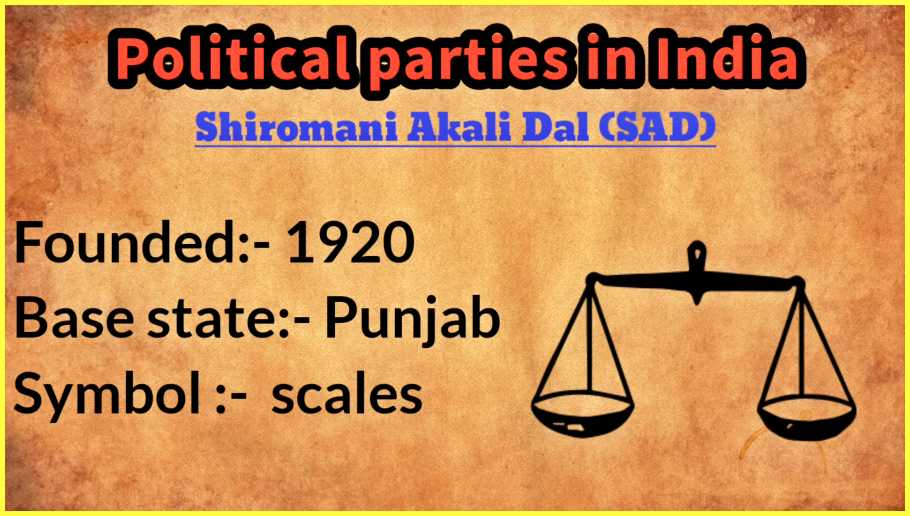
Here’s a detailed table providing an overview of Shiromani Akali Dal (SAD):
| Founded | 14th December 1920 |
|---|---|
| Founder | Sardar Sundar Singh Majithia and others |
| Current President | Sukhbir Singh Badal (as of last update) |
| Headquarters | Shiromani Akali Dal Head Office, Amritsar, Punjab, India |
| Ideology | Punjab Regionalism, Sikhism, Social Conservatism |
| Political Position | Centre-right to Right-wing |
| Alliance | National Democratic Alliance (NDA) |
| Symbol | Scale (Thapar) |
| Official Website | Shiromani Akali Dal |
| Key Historical Leaders | Sardar Parkash Singh Badal, Sukhdev Singh Dhindsa, Harcharan Singh Longowal |
| Major Achievements | Multiple Terms in Punjab Government, Advocacy for Sikh Rights, Social and Economic Development in Punjab |
Janata Dal (Secular) [JDS]
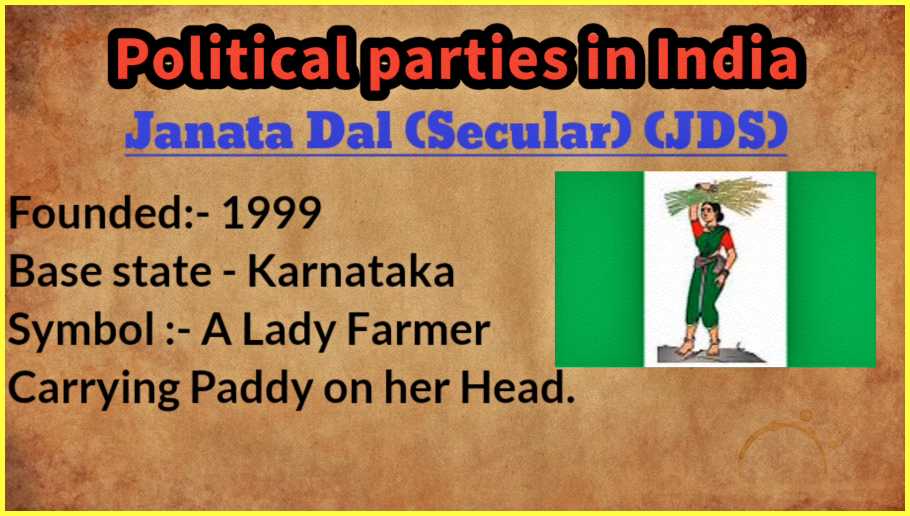
Here’s a detailed table providing an overview of Janata Dal (Secular) [JDS]:
| Founded | July 1999 |
|---|---|
| Founder | H.D. Deve Gowda |
| Current President | H.D. Kumaraswamy (as of last update) |
| Headquarters | JP Bhavan, Sheshadripuram, Bangalore, Karnataka, India |
| Ideology | Secularism, Social Democracy, Federalism |
| Political Position | Centre-left |
| Alliance | United Progressive Alliance (at the national level) |
| Symbol | Lady Farmer with Paddy and Cattle |
| Official Website | Janata Dal (Secular) |
| Key Historical Leaders | H.D. Deve Gowda, H.D. Kumaraswamy, H.D. Revanna |
| Major Achievements | Participation in Karnataka State Government, Advocacy for Farmers and Social Justice Issues |
Jammu & Kashmir National Conference (National Conference)
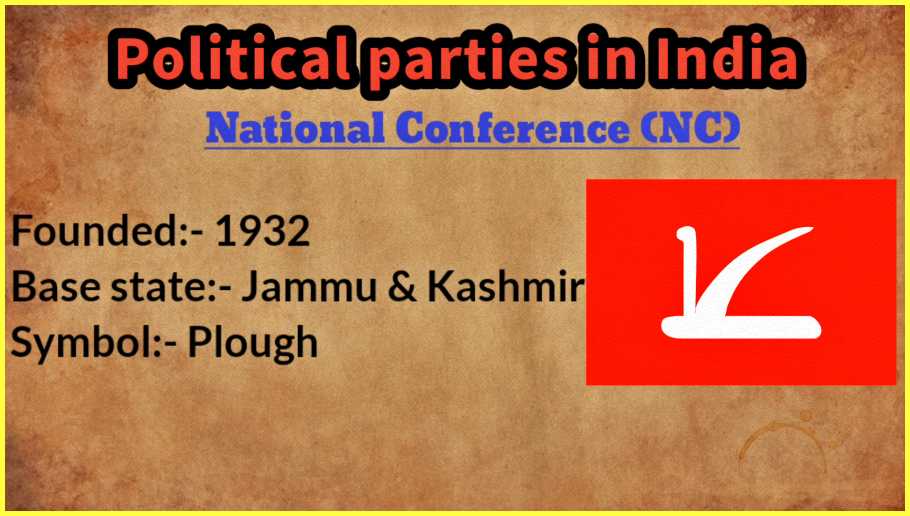
Here’s a detailed table providing an overview of the Jammu & Kashmir National Conference (National Conference):
| Founded | 1932 |
|---|---|
| Founder | Sheikh Abdullah |
| Current President | Farooq Abdullah (as of last update) |
| Headquarters | Hazratbal Rd, Near NIT Srinagar, Srinagar, Jammu & Kashmir, India |
| Ideology | Secularism, Autonomy for Jammu & Kashmir, Social Democracy |
| Political Position | Centre-left to Left-wing |
| Alliance | Gupkar Alliance (People’s Alliance for Gupkar Declaration) |
| Symbol | Plough (Hal) |
| Official Website | National Conference |
| Key Historical Leaders | Sheikh Abdullah, Farooq Abdullah, Omar Abdullah |
| Major Achievements | Multiple Terms in Jammu & Kashmir Government, Advocacy for Autonomy, Social Justice Reforms |
Jammu & Kashmir Peoples Democratic Party (PDP)
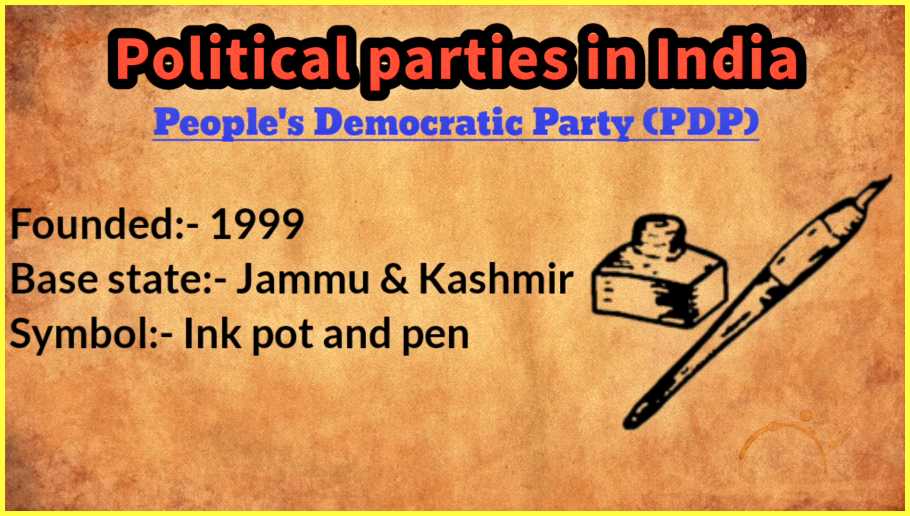
Here’s a detailed table providing an overview of Jammu & Kashmir Peoples Democratic Party (PDP):
| Founded | 28th July 1999 |
|---|---|
| Founder | Mufti Mohammad Sayeed |
| Current President | Mehbooba Mufti (as of last update) |
| Headquarters | PDP Office, Srinagar, Jammu & Kashmir, India |
| Ideology | Autonomy for Jammu & Kashmir, Self-Governance, Regionalism |
| Political Position | Centre-left |
| Alliance | Gupkar Alliance (People’s Alliance for Gupkar Declaration) |
| Symbol | Ink Pot & Pen |
| Official Website | Peoples Democratic Party |
| Key Historical Leaders | Mufti Mohammad Sayeed, Mehbooba Mufti |
| Major Achievements | Multiple Terms in Jammu & Kashmir Government, Advocacy for Autonomy, Social Justice Reforms |
Jharkhand Mukti Morcha (JMM)

Here’s a detailed table providing an overview of the Jharkhand Mukti Morcha (JMM):
| Founded | 22nd June 1972 |
|---|---|
| Founder | Shibu Soren |
| Current President | Shibu Soren (as of last update) |
| Headquarters | Shibu Soren Bhavan, Main Road, Ranchi, Jharkhand, India |
| Ideology | Tribal Rights, Regionalism, Social Justice, Tribal Autonomy |
| Political Position | Centre-left |
| Alliance | Mahagathbandhan (in Bihar), United Progressive Alliance (at the national level) |
| Symbol | Bow & Arrow (Dhanush Bān) |
| Official Website | Jharkhand Mukti Morcha |
| Key Historical Leaders | Shibu Soren, Hemant Soren |
| Major Achievements | Multiple Terms in Jharkhand Government, Advocacy for Tribal Rights, Social Justice Reforms |
#Lok Janshakti Party (LJP)
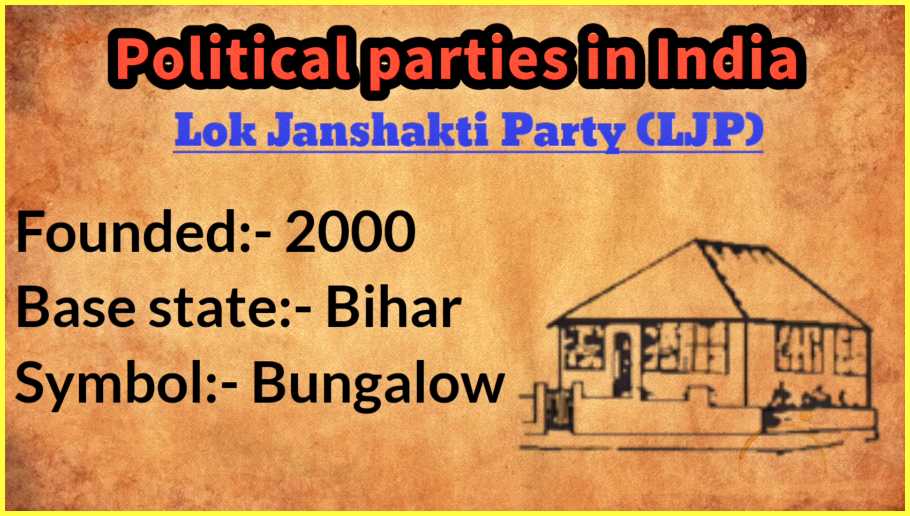
Here’s a detailed table providing an overview of the Lok Janshakti Party (LJP):
| Founded | 28th November 2000 |
|---|---|
| Founder | Ram Vilas Paswan |
| Current President | Chirag Paswan (as of last update) |
| Headquarters | Janpath, 12, Janpath, New Delhi, India |
| Ideology | Social Justice, Secularism, Development |
| Political Position | Centre |
| Alliance | National Democratic Alliance (NDA) |
| Symbol | Bungalow (Kothi) |
| Official Website | Lok Janshakti Party |
| Key Historical Leaders | Ram Vilas Paswan, Chirag Paswan |
| Major Achievements | Participation in Central and State Governments, Advocacy for Social Justice and Welfare, Implementation of Development Schemes |
List Of 26 Parties (‘I-N-D-I-A’ Alliance) Part Of Opposition Alliance That Will Take On NDA
The political landscape in India is set to witness a significant shift as 26 opposition parties have come together to form a united front called I-N-D-I-A, standing for Indian National Democratic Inclusive Alliance. This alliance, formed to challenge the BJP-led National Democratic Alliance (NDA) in the upcoming 2024 Elections, was formalized during a crucial meeting held in Bengaluru.
Here is the table representing the parties in the ‘I-N-D-I-A’ alliance as mentioned in the provided list:
| S. No. | Party | Abbreviation |
|---|---|---|
| 1. | Indian National Congress | INC |
| 2. | All India Trinamool Congress | TMC |
| 3. | Dravida Munnetra Kazhagam | DMK |
| 4. | Aam Aadmi Party | AAP |
| 5. | Janata Dal (United) | JD(U) |
| 6. | Rashtriya Janata Dal | RJD |
| 7. | Jharkhand Mukti Morcha | JMM |
| 8. | Nationalist Congress Party | NCP |
| 9. | Shiv Sena | UBT |
| 10. | Samajwadi Party | SP |
| 11. | Rashtriya Lok Dal | RLD |
| 12. | Apna Dal (Kamerawadi) | Apna Dal |
| 13. | Jammu and Kashmir National Conference | NC |
| 14. | Peoples Democratic Party | PDP |
| 15. | Communist Party of India (Marxist) | CPI(M) |
| 16. | Communist Party of India | CPI |
| 17. | Revolutionary Socialist Party | RSP |
| 18. | All India Forward Bloc | Forward Bloc |
| 19. | Marumalarchi Dravida Munnetra Kazhagam | MDMK |
| 20. | Viduthalai Chiruthaigal Katchi | VCK |
| 21. | Kongunadu Makkal Desia Katchi | KMDK |
| 22. | Communist Party of India (Marxist-Leninist) | CPI(ML) |
| 23. | Manithaneya Makkal Katchi | MMK |
| 24. | Indian Union Muslim League | IUML |
| 25. | Kerala Congress (M) | KC(M) |
| 26. | Kerala Congress (Joseph) | KC(J) |
These parties are part of the ‘I-N-D-I-A’ alliance that will be contesting in the upcoming elections against the ruling National Democratic Alliance, They (26 Parties) are Against BJP (Single Party).
How to register a New party in India?
Registering a new political party in India is a methodical process overseen by the Election Commission of India (ECI. Let’s walk through the steps with an example. Imagine a group of environmentally conscious individuals in India who want to establish a new political party named “Green Earth Guardians” (GEG).
- Eligibility Check: GEG starts by ensuring they meet the ECI’s eligibility criteria, which include having at least 100 members who are Indian citizens eligible to vote.
- Choosing a Unique Party Name: They select a unique and distinctive name, ensuring it doesn’t resemble the names of any existing registered parties. In this case, they opt for “Green Earth Guardians.”
- Constitution Drafting: GEG develops a comprehensive party constitution that outlines their mission, objectives, organizational structure, and decision-making procedures, all in alignment with the ECI’s guidelines.
- Core Committee Formation: To steer the registration process, GEG forms a core committee comprising dedicated members and experienced legal advisors.
- Bank Account Setup: They open a separate bank account exclusively for the party’s financial transactions, making sure it complies with financial regulations.
- Organizational Meetings: GEG conducts regular meetings to build the party’s infrastructure, appoint office bearers, and delegate responsibilities.
- Membership Drive: They actively recruit members who share their environmental concerns, aiming to reach the required threshold of 100 members.
- Symbol and Flag Design: Adhering to the ECI’s guidelines, GEG designs a unique party symbol, let’s say, a “Green Tree,” symbolizing environmental protection and growth.
- Application Submission: They complete the application form, attaching essential documents, including the party constitution, list of members, and symbol design.
- Application Review: The ECI reviews their application for compliance with legal requirements, including ensuring that they have the requisite 100 members.
- Public Notice: A public notice is published by the ECI, inviting any objections and suggestions from the public within a stipulated timeframe.
- ECI Decision: After evaluating any objections or comments, the ECI makes a decision on granting or rejecting GEG’s registration.
- Symbol Allotment: If approved, the ECI allots a unique party symbol, such as a “Green Earth,” signifying their environmental focus.
- Certificate of Registration: Upon successful registration, the ECI issues a certificate officially recognizing “Green Earth Guardians” as a registered political party in India.
- Election Participation: With their registration, GEG gains the rights to participate in local, state, and national elections, nominate candidates, and actively campaign, championing their environmental agenda.
This example demonstrates the meticulous process of registering a new political party in India, emphasizing the importance of adherence to the Election Commission’s guidelines and requirements.
Conclusion:
- India’s political landscape is as diverse and varied as the country itself. The multitude of political parties, each representing unique ideologies and constituencies, is a testament to the nation’s democratic spirit. As India continues its journey as a democratic republic, these political entities will continue to shape the nation’s destiny, reflecting the hopes and aspirations of its people.
Also Read:
